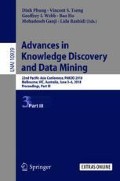Abstract
This study aims to visualize financial documents to swiftly obtain market sentiment information from these documents and determine the reason for which sentiment decisions are made. This type of visualization is considered helpful for nonexperts to easily understand technical documents such as financial reports. To achieve this, we propose a novel interpretable neural network (NN) architecture called gradient interpretable NN (GINN). GINN can visualize both the market sentiment score from a whole financial document and the sentiment gradient scores in concept units. We experimentally demonstrate the validity of text visualization produced by GINN using a real textual dataset.
Access this chapter
Tax calculation will be finalised at checkout
Purchases are for personal use only
References
Ravi, K., Ravi, V.: A survey on opinion mining and sentiment analysis: tasks, approaches and applications. Knowl.-Based Syst. 89(C), 14–46 (2015)
Hechtlinger, Y.: Interpretation of prediction models using the input gradient. In: NIPS 2016 Workshop on Interpretable Machine Learning in Complex Systems (2016)
Bach, S., Binder, A., Montavon, G., Klauschen, F., Muller, K.R., Samek, W.: On pixel-wise explanations for nonlinear classifier decisions by layer-wise relevance propagation. PLoS ONE 10(7), 1–46 (2015)
Mikolov, T., Chen, K., Sutskever, I., Corrado, G., Dean, J.: Distributed representations of words and phrases and their compositionality. In: NIPS 2013, pp. 3111–3119 (2013)
Hornik, K., Feinerer, I., Kober, M., Buchta, C.: Spherical k-means clustering. J. Stat. Softw. 50(10), 1–22 (2012)
Zhao, P., Zhang, T.: Accelerating minibatch stochastic gradient descent using stratified sampling. arXiv:1405.3080v1 (2014)
Kingma, D.P., Ba., J.L.: Adam: a method for stochastic optimization. In: ICLR 2015 (2015)
Srivastava, N., Hinton, G., Krizhevsky, A., Sutskever, I., Salakhutdinov, R.: Dropout: a simple way to prevent neural networks from overfitting. J. Mach. Learn. Res. 15(1), 1929–1958 (2014)
Kjellin, P.E., Liu, Y.: A survey on interactivity in topic models. IJACSA 7(14), 456–461 (2016)
Tandem anchoring: a multiword anchor approach for interactive topic modeling. In: ACL 2017, pp. 896–905 (2017)
Shrikumar, A., Greenside, P., Kundaje, A.: Learning important features through propagating activation differences. In: ICML 2017 (2017)
Xu, Q., Zhao, Q., Pei, W., Yang, L., He, Z.: Design interpretable neural network trees through self-organized learning of features. In: IJCNN 2004 (2004)
Zhang, Q., Wu, Y.N., Zhu, S.: Interpretable convolutional neural networks. arXiv:1710.00935 (2017)
Mnih, V., Heess, N., Graves, A., Kavukcuoglu, K.: Recurrent models of visual attention. In: NIPS 2014, pp. 2204–2212 (2014)
Xu, K., Ba, J., Kiros, R., Cho, K., Courville, A., Salakhutdinov, R., Zemel, R., Bengio, Y.: Show, attend and tell: neural image caption generation with visual attention. In: ICML 2015, pp. 77–81 (2015)
Dong, Y., Su, H., Zhu., J, Zhang, B.: Improving interpretability of deep neural networks with semantic information. In: CVPR 2017 (2017)
Acknowledgment
This work was supported in part by JSPS Fellows Grant Number 17J04768.
Author information
Authors and Affiliations
Corresponding author
Editor information
Editors and Affiliations
1 Electronic supplementary material
Below is the link to the electronic supplementary material.
Theoretical Analysis of the II Algorithm
Theoretical Analysis of the II Algorithm
Let \(\varOmega _{dw}^{(k)}\) be a set of words included in the kth cluster and included in the polarity dictionary, \(D^{(p)}\) and \(D^{(n)}\) be the positive and negative document sets, \(\partial {w}_{k, i}^{(2)*}\) be the ith component of \(\partial \varvec{w}_{k}^{(2)*}\), \(p^{-}(w_{k,i})\) be \(p \left( j \in D^{(n)} | z_{j, i}^{(1, k)} > 0\right) \), \(p^{+}(w_{k,i})\) be \(1 - p^{-}(w_{k,i})\), and \(\partial \varvec{H}^{(j, t)}\) be the gradient value of \(\varvec{H}^{(j, t)}\) in Update. Then,
Proposition 1
If we utilize Update for the parameter updates, then,
is established. Proposition 1 indicates that if Cond 1: the values of \({t^+}\) and \({t^-}\) are sufficiently large, and Cond 2: for every word \(w_{k,i^{+}} \in \varOmega _{dw}^{(k)} \cap \varOmega _{pw}^{(k)}\), and \(w_{k,i^{-}} \in \varOmega _{dw}^{(k)} \cap \varOmega _{nw}^{(k)}\), the initial values of \(w^{(2)}_{k,i^{+}}\) and \(w^{(2)}_{k,i^{-}}\) given by Init are positive and sufficiently large, and negative and sufficiently small, respectively, are met for every k, then, the II algorithm is expected to award each positive word \(\in \varOmega _{pw}^{(k)}\) (negative word \(\in \varOmega _{nw}^{(k)})\) a positive (negative) sentiment score.
Let \({\varvec{H}^{d}}^{(j, t)}\) be \(\varvec{H}^{(j, t)} - {\varvec{H}^{*}}^{(j, t)}\). Then, the following propositions important for explaining the market mood predictability of GINN are established.
Proposition 2
If the initial values of \(|\varvec{W^{(3)}}|\) and \(|\varvec{W^{(4)}}|\) are sufficiently small (Cond 3) and for every \(j \in \varOmega ^{(t)}_m\), the values of \(\varvec{z}^{(2)}_{j}\) are \( \left\{ \begin{array}{cc} positive &{} (j \in D^{(p)}) \\ negative &{} (j \in D^{(n)}) \end{array} \right. \), then, the first and second row vector values of \(\partial \varvec{H}^{(j, t)}\) are positive and negative respectively, and \( \frac{\sum _{j \in \varOmega ^{(t+1)}_m} \Vert {\varvec{H}^{d}}^{(j, t+1)} \Vert _{1} }{\sum _{j \in \varOmega ^{(t+1)}_m} \Vert \varvec{H}^{(j, t+1)}\Vert _{1}} \le \frac{\sum _{j \in \varOmega ^{(t+1)}_m} \Vert {\varvec{H}^{d}}^{(j, t)} \Vert _{1} }{\sum _{j \in \varOmega ^{(t+1)}_m} \Vert \varvec{H}^{(j, t)}\Vert _{1}}. \)
Proposition 3
If, for every k, Cond 1–3 are established, the values \(|\varOmega _{pw}^{(k, t^+)}|\), \(|\varOmega _{nw}^{(k, t^-)}|\) and \(|\varOmega _m|\) are sufficiently large, then, \(\lim _{t \rightarrow \infty } \frac{\sum _{j \in \varOmega ^{(t)}_m} \Vert {\varvec{H}^{d}}^{(j, t)} \Vert _{1} }{\sum _{j \in \varOmega ^{(t)}_m} \Vert \varvec{H}^{(j, t)}\Vert _{1}} = 0.\)
See the supplementary material (See footnote 2) for the proofs and the details.
Rights and permissions
Copyright information
© 2018 Springer International Publishing AG, part of Springer Nature
About this paper
Cite this paper
Ito, T., Sakaji, H., Tsubouchi, K., Izumi, K., Yamashita, T. (2018). Text-Visualizing Neural Network Model: Understanding Online Financial Textual Data. In: Phung, D., Tseng, V., Webb, G., Ho, B., Ganji, M., Rashidi, L. (eds) Advances in Knowledge Discovery and Data Mining. PAKDD 2018. Lecture Notes in Computer Science(), vol 10939. Springer, Cham. https://doi.org/10.1007/978-3-319-93040-4_20
Download citation
DOI: https://doi.org/10.1007/978-3-319-93040-4_20
Published:
Publisher Name: Springer, Cham
Print ISBN: 978-3-319-93039-8
Online ISBN: 978-3-319-93040-4
eBook Packages: Computer ScienceComputer Science (R0)

